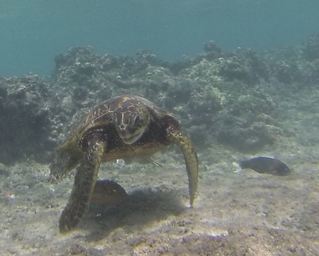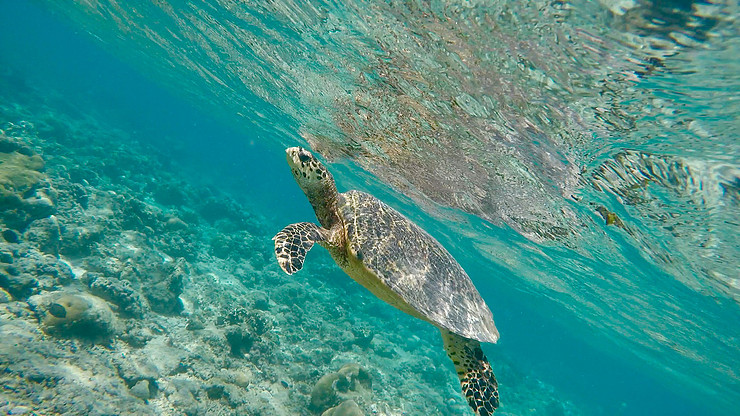Sea turtles should not be touched because it can disrupt their natural behaviors and stress them. Touching sea turtles can also remove the protective layer of mucus on their skin, making them susceptible to infections.
Sea turtles play a crucial role in maintaining the health of marine ecosystems. They help control populations of jellyfish and seagrass, contributing to a balanced ocean environment. Interfering with sea turtles can harm their ability to fulfill these vital ecological functions.
It is essential to respect and protect these magnificent creatures to ensure their survival for future generations. By observing from a distance and supporting conservation efforts, we can help safeguard the well-being of sea turtles and the oceans they call home.

Credit: m.facebook.com
Physical Vulnerabilities
Sea turtles are physically vulnerable creatures, and touching them can cause harm. Their shells are not just protection but also part of their body, and touching them can disrupt their natural processes. It’s important to keep a safe distance and admire these magnificent creatures from afar.
Physical Vulnerabilities.Sensitive Skin
Sea turtles have highly sensitive skin that can be easily damaged by human touch.Shell Structure
The shell structure of sea turtles is crucial for their protection and any contact can harm them.Legal Protection
Sea turtles are fascinating creatures that have roamed the oceans for millions of years. Unfortunately, they are also endangered, and their populations are declining rapidly. As a result, sea turtles are legally protected in many countries around the world. In this article, we will explore the legal protections that prevent people from touching sea turtles.
Endangered Species Act
The Endangered Species Act (ESA) is a law that was passed in the United States in 1973. It is designed to protect endangered and threatened species from becoming extinct. The ESA makes it illegal to harm, harass, or kill sea turtles, and it also prohibits people from touching them. In fact, it is illegal to touch sea turtles or their nests in the United States, and violators can face fines and even jail time.
International Laws
Sea turtles are not just protected in the United States. They are also protected by international laws. For example, the Convention on International Trade in Endangered Species of Wild Fauna and Flora (CITES) is an international agreement that regulates the trade of endangered and threatened species. All species of sea turtles are listed under Appendix I of CITES, which means that international trade in sea turtles or their products is illegal.
In addition to CITES, there are other international agreements that protect sea turtles. The Inter-American Convention for the Protection and Conservation of Sea Turtles is an agreement between countries in the Americas that aims to protect sea turtles and their habitats. The Convention on Migratory Species is another international agreement that aims to protect migratory animals, including sea turtles.
Conclusion
Sea turtles are fascinating creatures that are in danger of extinction. Legal protections are in place to prevent people from harming or harassing sea turtles, including touching them. By respecting these laws and regulations, we can help ensure that sea turtles continue to thrive in our oceans for generations to come.
Conservation Efforts
Research And Monitoring
Beach Cleanup Initiatives

Credit: www.hawaiioceanambassadors.com
Human Interference
Human interference has posed a significant threat to sea turtles, impacting their natural habitat and overall survival. Pollution and habitat destruction are two major consequences of human activities that have detrimental effects on these marine creatures.
Pollution
Pollution, particularly plastic waste, poses a severe threat to sea turtles. When turtles mistake plastic bags for jellyfish, a common part of their diet, it can lead to ingestion and digestive issues, often proving fatal. Chemical pollutants in the water also affect their health and reproductive capabilities, further endangering their populations.
Habitat Destruction
Habitat destruction due to coastal development, such as beachfront resorts and infrastructure, disrupts the nesting and feeding grounds of sea turtles. Artificial lighting along coastlines disorients hatchlings, leading them away from the ocean, while the destruction of mangroves and coral reefs deprives turtles of essential habitats for feeding and shelter.
Tourism Impact
When it comes to the impact of tourism on sea turtles, it’s crucial to consider responsible practices and educational programs that can help protect these majestic creatures. Sea turtles face numerous threats, and tourism can have both positive and negative effects on their well-being.
Responsible Tourism Practices
Responsible tourism practices play a significant role in minimizing the negative impact of tourism on sea turtles. Tourists should be educated about the importance of respecting the natural habitats of these creatures and the potential harm that human interaction can cause. Limiting the number of visitors to nesting beaches and implementing strict guidelines for boat and water activities are essential measures in preserving the welfare of sea turtles.
Educational Programs
Educational programs are key in raising awareness among tourists about the vulnerability of sea turtles and the significance of conservation efforts. These programs can include guided tours by knowledgeable experts, interactive exhibits, and informative signage that highlight the importance of protecting sea turtle habitats. By promoting understanding and empathy, educational initiatives can inspire tourists to become advocates for sea turtle preservation.
Myths And Misconceptions
Myth: Sea Turtles Are Harmful
Contrary to popular belief, sea turtles are not harmful to humans. In fact, they are gentle creatures that play a vital role in maintaining the balance of marine ecosystems. The misconception that sea turtles pose a threat to humans has been perpetuated by misinformation and sensationalism in the media.
Misconception: Touching Helps Them
Many people mistakenly believe that touching sea turtles can be beneficial for them. However, the reality is quite the opposite. Touching sea turtles can cause them stress and anxiety, disrupting their natural behavior and potentially leading to negative consequences for their health and well-being.

Credit: www.reddit.com
Conclusion
It’s crucial to protect sea turtles by avoiding physical contact. By understanding the potential harm we can cause, we can contribute to their conservation. Let’s spread awareness and respect their natural habitat to ensure the survival of these magnificent creatures for future generations to enjoy.






Leave a Reply